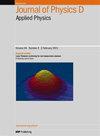Post-mortem study and long cycling stability of silica/carbon composite as anode in Li-ion cells
IF 3.2
3区 物理与天体物理
Q2 PHYSICS, APPLIED
引用次数: 0
Abstract
The present work emphases on the post-mortem study of silica/carbon composite as functional anode in Li-ion batteries (LIBs). Herein, the silica/carbon composite is synthesized by facile in-situ hydrothermal technique. The x-ray diffraction (XRD) pattern indicates the amorphous nature of silica/carbon composite. The stacked sheet-like morphology of silica/carbon composite is seen in the high-resolution transmission electron microscopy (HR-TEM) & scanning electron microscopy (SEM) images. In addition, Raman spectroscopy, Fourier transform infrared (FTIR) spectroscopy, energy dispersive x-ray analysis (EDAX), and x-ray photoelectron spectra (XPS) characterizations of silica/carbon composite has been studied in detail. The rate capability of silica/carbon composite anode in LIB indicates 99% capacity retention after applying current density ranging from 50 mA g−1 to 1000 mA g−1, successively. The composite anode delivers a stable specific capacity ∼300 mAh g−1 at a current density of 100 mA g−1 for 500 cycles. Electrochemical impedance spectroscopy (EIS) study analyzed the faster Li-ion diffusion and increment in the diffusion coefficient by a factor of 1000 after 500 cycles. To the best of our knowledge, this is the first work on the post-mortem study of silica/carbon composite as anode in LIB. Post-cycling characterizations including XRD, FTIR, and SEM reveal the absence of any impurity phases and negligible volumetric expansion after prolonged cycling. It further confirms that the carbon present in the silica/carbon composite helps to accommodate the volumetric expansion of silica and prevents cracking of the anode over 500 cycles.二氧化硅/碳复合材料作为锂离子电池阳极的死后研究和长循环稳定性
本研究的重点是对二氧化硅/碳复合材料作为锂离子电池(LIB)功能阳极的后期研究。本文采用简便的原位水热技术合成了二氧化硅/碳复合材料。X 射线衍射(XRD)图表明二氧化硅/碳复合材料具有无定形性质。从高分辨率透射电子显微镜(HR-TEM)和扫描电子显微镜(SEM)图像中可以看到二氧化硅/碳复合材料的叠层片状形态。此外,还详细研究了二氧化硅/碳复合材料的拉曼光谱、傅立叶变换红外光谱、能量色散 X 射线分析和 X 射线光电子能谱特性。二氧化硅/碳复合阳极在 LIB 中的速率能力表明,在电流密度从 50 mA g-1 到 1000 mA g-1 的范围内,其容量保持率为 99%。在 100 mA g-1 的电流密度下,该复合阳极可在 500 个循环中提供稳定的比容量 ∼300 mAh g-1。电化学阻抗谱(EIS)研究分析表明,500 次循环后,锂离子扩散速度加快,扩散系数增加了 1000 倍。据我们所知,这是首次对二氧化硅/碳复合材料作为 LIB 负极进行死后研究。包括 XRD、傅立叶变换红外光谱和 SEM 在内的循环后特性分析表明,在长时间循环后,该材料不存在任何杂质相,体积膨胀也可以忽略不计。这进一步证实了二氧化硅/碳复合材料中存在的碳有助于适应二氧化硅的体积膨胀,防止阳极在 500 次循环后出现裂纹。
本文章由计算机程序翻译,如有差异,请以英文原文为准。
求助全文
约1分钟内获得全文
求助全文
来源期刊
CiteScore
6.80
自引率
8.80%
发文量
835
审稿时长
2.1 months
期刊介绍:
This journal is concerned with all aspects of applied physics research, from biophysics, magnetism, plasmas and semiconductors to the structure and properties of matter.

 求助内容:
求助内容: 应助结果提醒方式:
应助结果提醒方式:


